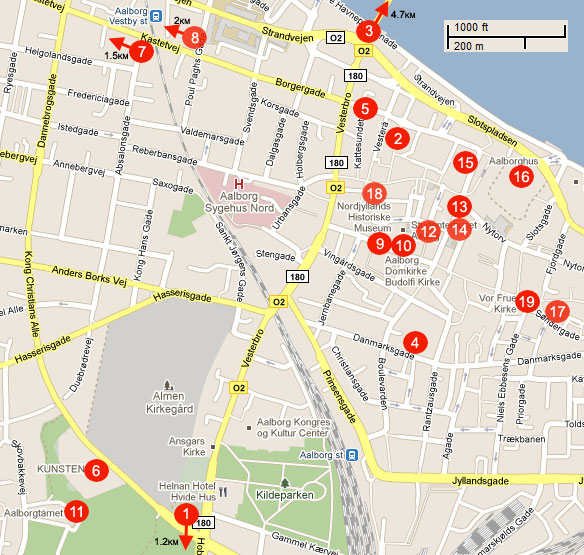Aalborg - Things to See and Do Part 1

1. Aalborg Zoo (Aalborg Zoologiske Have). Aalborg Zoo is one of the oldest, yet one of the most modern zoos in all of Denmark. The zoo is a great place to bring the family. Located within the city on Mølleparkvej 63. The polar bears, giraffes and sea lions, are just a few of the 140 different animals the zoo has to offer. Aalborg Zoo is one of the finest zoos in Denmark. There is also a museum on the grounds with temporary exhibitions focusing on different aspects of the natural and animal world.
2. Virgin Anne's Street (Jomfru Ane Gade). Virgin Anne’s Street or Jomfru Ane Gade is one of the most famous streets in Denmark. The street dates back at least until the end of the 16th century. Today it is very popular with both locals and tourists for its lively atmosphere. The street is packed with restaurants and pubs on both sides of the street. It is the longest continuous stretch of restaurants and bars in Denmark. During the day it is a great place to relax, grab a bite to eat or simply enjoy a little people watching. At night it is the heart of Aalborg’s nightlife, with many bars, discos and live music.
3. Lindholm Hoje Museum (Lindholm Høje Museum). Lindholm Hoje Museum is an absolute must for anyone with an interest in the Viking Age. The museum is one of the most impressive Viking Age sites in Scandinavia. The museum has both an indoor and an outdoor section. The outdoor section is a burial site with close to 700 graves from the Viking Age and the Iron Age. Hundreds of stones have been placed in the shape of circles and ships to mark the graves. There’s a great view of Aalborg over the Limfjord waterway from the top of the hill. The indoor section of the museum holds to main archaeological exhibitions. One section tells the story of how people lived and died during The Iron Age and The Viking Age. The other one tells the story about life in and around Limfjord in ancient history. Technically the museum is located 3 km outside of Aalborg in Norresundby (Nørresundby) on Vendilavej 11. You can enjoy a meal at museum’s café which has a great view over the Limfjord.
4. The Grey Brother Monastery (Gråbrødreklosteret). The Grey Brother Monastery is a very interesting and often overlooked site in Aalborg. The site is essentially a very well preserved underground ruin of the original monastery which was constructed here around the year 1250. Archaeologists excavated the site in 1994-1995. Visitors can access the ruins via the elevator tower outside the Salling Shopping Mall. The mini-museum has an exhibit about the monastic life in Aalborg during The Middle Age, and of course you can see the original foundation and bricked basements of the monastery. Open every day except Mondays from 10-17.
5. The Craftsman’s House (Håndværkerhuset). The Craftsman’s House is a beautiful yellow and black timber framed warehouse which was built in 1630. It was once part of an enormous merchant's house which has since been torn down. Today the building houses several traditional workshops. The centre’s goal is to preserve the knowledge and traditional skills used by craftsmen prior to the industrial revolution. The Craftsman’s House has the following workshops: a blacksmith, a coppersmith, a watchmaker and a carpentry workshop. You can order guided tours through the workshops by phoning (+45) 98 12 52 32
6. Northern Jutland Art Museum (Nordjyllands Kunstmuseum). The museum is located on Kong Christians Allé. The building was designed by the world famous Finnish architect Alvar Aalto (1898-1976), his wife Elissa Aalto and Jean-Jacques Baruël in 1972. The building itself is a site worth seeing, especially the interior. The museum has an impressive collection which focuses on modern Danish and foreign art from the 20th century. The museum also houses many impressive temporary art exhibitions.
7. Aalborg Seafaring- and Marine Museum (Aalborg Søfarts- og Marinemuseum). The museum is located on Fjordvej 81. The museum tells the story about life on the sea life in Aalborg harbour (Aalborg Havn). Denmark is proud of their maritime history. In the outdoor section of the museum known as the Aalborg Shipyard (Aalborg Værft) you have the opportunity to board the Danish built submarine called, “The Springer” (Springeren), and the torpedo boat called, “The Sea Bear” (Søbjørnen). Both were built in the 1960’s. Other artefacts in the museum’s collection include a mini German submarine from World War II, Danish Navy uniforms, diving equipment, mines and a marine helicopter.
8. Defence and Garrison Museum (Forsvars- og Garnisonsmuseum). Aalborg’s Defence and Garrison Museum is located on Skydebanevej 22. The museum exhibits combat vehicles, fighter planes, cannons, uniforms, and other equipment in a giant hangar. The hangar was built by the Germans in 1940 during their occupation of Denmark. An interesting section of the museum analyses the German occupation of Denmark during World War II.
9. Aalborg’s Historical Museum (Aalborg’s Historiske Museum). Aalborg Historical Museum (also known as: Nordjyllands Historiske Museum) is a decent museum which runs through the history of the city from ancient times right up to the present. The museum is located on Algade 48. There is also a fine collection of glass and silver from Northern Jutland.
10. Budolfi Church (Budolfi Kirke). Aalborg’s Budolfi Church was originally built in the 14th century, and it is one of the finest churches in Northern Jutland. The church steeple was destroyed in a fire in 1663 which was replaced in 1779 by a very elegant cobber baroque spire. The interior of the church holds frescos from the early 15th century. Of particular interest is the enormous baroque inspired altarpiece which was added to the church in 1689. The Church is named after the popular English saint “St Botolph”.
Aalborg - Things to See and Do (Part 2)
Aalborg - Main Page
LastUpdate: 2016-07-06 10:09:34
